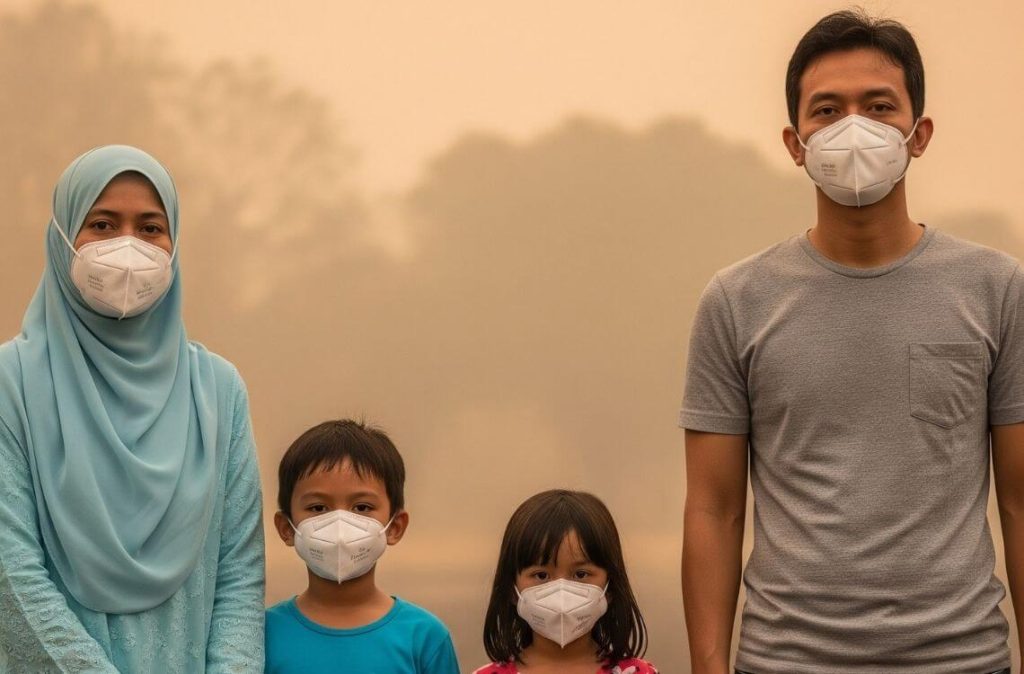If you’ve stepped outside recently and noticed the sky looking grey and your throat feeling scratchy, you’re not alone.
The haze is back, and it’s more than just unpleasant. It’s harmful.
Most haze in Malaysia comes from transboundary air pollution, specifically forest and peatland fires in Sumatra and Kalimantan, Indonesia, caused by open burning for agriculture during the dry season (typically between August and October)
These fires release PM2.5 particles – tiny bits of ash and pollutants that can easily enter your lungs and bloodstream.
Who’s Most at Risk?
Children, pregnant women, the elderly, and anyone with asthma, sinus issues, or skin conditions are more vulnerable to the effects of haze.
Children, in particular, breathe more rapidly and are more sensitive to air pollution, making them highly susceptible.
How to Protect Your Family from the Haze
When the haze hits, the effects aren’t just felt in the sky or through scratchy throats – it’s a direct concern for your family’s health, especially your children.
The good news is, there are practical, simple steps you can take to reduce the risk.
Here’s what every parent should be doing when the air quality worsens.
1. Stay Indoors When API Levels Are High
The first and most important step is knowing when the air outside is no longer safe.
If the Air Pollution Index (API) rises above 100, it’s considered unhealthy, particularly for sensitive groups like children and the elderly.
On those days, try to keep your family indoors as much as possible.
Close all windows and doors during the day to prevent smoke and fine particles from entering your home.
If you have an air purifier, make sure it’s running – ideally one with a HEPA filter, which can help remove harmful PM2.5 particles from the air inside your home.
2. Use Proper Face Masks Outdoors
If you or your child absolutely must go outside during hazy days, wearing the right type of mask is crucial.
Not all masks are created equal – while surgical or cloth masks may block large droplets, they’re not designed to filter out the tiny PM2.5 particles present during haze.
Look for N95 or KN95 masks, which are specifically made to filter fine pollutants.
For children, ensure the mask fits snugly to their face without gaps, as an ill-fitting mask won’t provide effective protection.
3. Drink Warm or Room Temperature Water
It might be tempting to reach for iced drinks to cool down, but during the haze, warm or room-temperature water is actually better for your respiratory system.
Cold beverages can sometimes constrict the airways, which isn’t ideal if you or your child are already feeling the effects of poor air quality.
Staying hydrated helps your body flush out toxins and keeps the throat moist.
Encourage kids to sip water frequently, and consider offering water-rich fruits like watermelon, cucumber, or oranges as snacks to support hydration.
4. Improve Air Quality Indoors
If you don’t have an air purifier, there are still simple things you can do to help reduce indoor air pollutants.
One effective tip is to place damp towels around windows and under door gaps to trap fine particles before they enter your home.
Another option is to gently boil a pot of water with lemon slices, which not only adds humidity to dry indoor air, but also leaves your home smelling fresher.
Just remember to avoid vacuuming unless you’re using a vacuum cleaner with a HEPA filter, as vacuuming can stir up dust and particles into the air.
5. Keep Children Occupied with Indoor Activities
When outdoor play isn’t an option, keeping kids active and entertained indoors can be a challenge.
But it’s also a great opportunity to get creative.
Set up a mini obstacle course using pillows and blankets.
For quieter moments, try printing colouring sheets or making use of all those extra cardboard boxes to paint.
These activities not only reduce screen time but also help your child feel less restricted during periods of poor air quality.
6. Watch for Signs of Discomfort or Illness
During haze season, it’s important to be aware of how your child is feeling.
Watch out for common haze-related symptoms like dry coughing, wheezing, irritated eyes, fatigue, or shortness of breath.
Don’t brush off these signs, especially if they persist beyond two to three days.
If you notice any unusual symptoms or if your child has an existing condition like asthma that seems to be worsening, consult a doctor.
Early action can help prevent more serious health complications.
7. Support Recovery with Gentle Remedies
If your child is experiencing mild irritation due to the haze, there are a few comforting remedies you can try.
Warm honey and lemon water can soothe a dry, itchy throat, and nasal saline sprays can help flush out any fine particles trapped in the nose.
Some supplements like vitamin C, omega-3 fatty acids, and probiotics, have been shown to support immune and respiratory health.
However, these remedies should always be used alongside and not in place of medical advice, especially for children with underlying health issues.
Stay Calm, Stay Ready
The haze is something we face almost every year – but every year, we have a choice in how we respond.
By staying informed and taking small but consistent steps, we can protect our children from the worst effects of poor air quality.
Our little ones look to us for safety and guidance.
If you found this article helpful, share it with your family WhatsApp groups, school chats, or parenting circles.
Together, we can keep our families safe!
Disclaimer: The information provided in this article is for informational purposes only and should not be considered as medical advice from Motherhood. For any health-related concerns, it is advisable to consult with a qualified healthcare professional or medical practitioner.
For more insightful stories and fun recipes, stay tuned to Motherhood Story!
